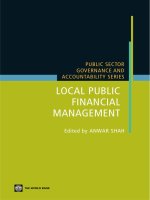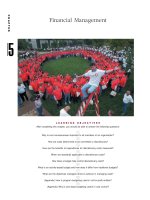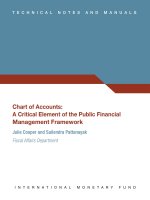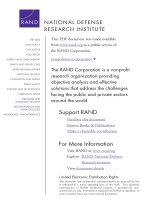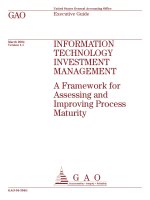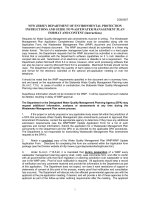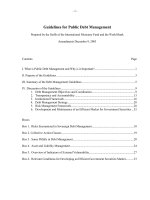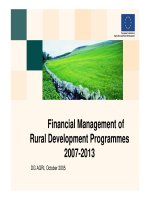assessing and reforming public financial management
Bạn đang xem bản rút gọn của tài liệu. Xem và tải ngay bản đầy đủ của tài liệu tại đây (1.08 MB, 165 trang )
Assessing
and Reforming
Public Financial
Management
A New Approach
Richard Allen
Salvatore Schiavo-Campo
Thomas Columkill Garrity
Assessing and Reforming Public Financial Management
T
his book was written as part of the work of the Public Expenditure
and Financial Accountability (PEFA) Program, a partnership of the
World Bank; the European Commission; the International Monetary Fund;
the Strategic Partnership with Africa; and several bilateral donor agencies,
including those of France, Norway, Switzerland, and the United Kingdom.
This study compares and contrasts the various instruments and
approaches used by these organizations to assess and reform public
expenditure management systems in developing and transitional countries.
It finds weaknesses in these instruments, including overlap and duplication
in their technical scope and coverage, as well as insufficient or inconsistent
coverage in some areas. In addition, countries often are subjected to
multiple assessments and multiple missions by the donors, which can
impose heavy transactions costs on government agencies. Furthermore,
the instruments have a variety of objectives—fiduciary, surveillance, and
capacity building—which are divergent and potentially conflicting.
This study recommends a new approach that is country led, multidonor,
medium term in orientation, focused on better management of the budget,
and supplemented by donor aid funds, as a key mechanism to reduce
poverty and attain other policy goals. It provides concrete and practical
recommendations for achieving four important objectives:
• Streamlining the coverage of instruments to avoid unnecessary
duplication
• Enhancing collaboration between donors, governments, and other
stakeholders
• Providing a more complete, accurate, and timely assessment of
fiduciary risk
• Improving the ultimate development impact of assessment and
reform work
This book will be of interest to development practitioners in the area
of public finance, finance ministers, policy analysts, and students and
scholars of international development.
0-8213-5599-6
TeAM
YYePG
Digitally signed by TeAM
YYePG
DN: cn=TeAM YYePG, c=US,
o=TeAM YYePG, ou=TeAM
YYePG, email=yyepg@msn.
com
Reason: I attest to the accuracy
and integrity of this document
Date: 2005.01.25 14:37:52
+08'00'
Assessing and
Reforming Public
Financial Management
A New Approach
Richard Allen
Salvatore Schiavo-Campo
Thomas Columkill Garrity
THE WORLD BANK
© 2004 The International Bank for Reconstruction and Development /
The World Bank
1818 H Street, N.W.
Washington, D.C. 20433
Telephone 202-473-1000
Internet www.worldbank.org
All rights reserved.
1 2 3 4 07 06 05 04
The findings, interpretations, and conclusions expressed herein are those of the
author(s) and do not necessarily reflect the views of the Board of Executive
Directors of the World Bank or the governments they represent.
The World Bank does not guarantee the accuracy of the data included in this
work. The boundaries, colors, denominations, and other information shown on
any map in this work do not imply any judgment on the part of the World Bank
concerning the legal status of any territory or the endorsement or acceptance of
such boundaries.
Rights and Permissions
The material in this work is copyrighted. Copying and/or transmitting portions
or all of this work without permission may be a violation of applicable law. The
World Bank encourages dissemination of its work and will normally grant per-
mission promptly.
For permission to photocopy or reprint any part of this work, please send a
request with complete information to the Copyright Clearance Center, Inc., 222
Rosewood Drive, Danvers, MA 01923, USA, telephone 978-750-8400, fax 978-
750-4470, www.copyright.com.
All other queries on rights and licenses, including subsidiary rights, should be
addressed to the Office of the Publisher, World Bank, 1818 H Street, N.W.,
Washington, D.C. 20433, USA, fax 202-522-2422, e-mail pubrights@world
bank.org.
Library of Congress Cataloging-in-Publication Data
Allen, Richard, 1944 Dec. 13-
Assessing and reforming public financial management: a new
approach/Richard Allen, Salvatore Schiavo-Campo, Thomas Columkill Garrity.
p. cm.
Includes bibliographic references and index.
ISBN 0-8213-5599-6
1. Finance, Public. 2. Expenditures, Public. I. Schiavo-Campo, Salva-
tore. II. Garrity, Thomas Columkill, 1967– III. Title.
HJ141.A454 2003
352.4—dc22 2003061163
Preface vii
Acknowledgmentsix
Executive Summaryxi
Abbreviations and Acronymsxix
ASSESSMENTS OF PUBLIC EXPENDITURE MANAGEMENT:
RATIONALE AND CONTEXT 1
What Is Public Expenditure Management? 2
This Study’s Purpose and Objectives 2
Genesis of Assessments of Public Expenditure
Management and Financial Accountability 3
FIDUCIARY RISK AND FINANCIAL ACCOUNTABILITY 9
Risk 10
Accountability 12
Operational Implications 13
THE MAIN INSTRUMENTS FOR ASSESSMENTS 15
World Bank Public Expenditure Reviews 17
World Bank Country Financial Accountability
Assessments 18
World Bank Country Procurement Assessment Reports 19
IMF Reports on the Observance of Standards and
Codes of Fiscal Transparency 20
Contents
World Bank–IMF Public Expenditure Tracking Assessments
and Action Plans for Heavily Indebted Poor Countries 21
EC Audits 22
DFID Assessments of Fiduciary Risk 23
Questionnaires, Checklists, and Other Tools 23
METHODOLOGY AND MAIN FINDINGS 27
Methodology and Sources 27
Coverage of the Instruments 34
Similarities 35
Differences 40
Institutional and Governance Content 41
Summary 44
RECOMMENDATIONS AND ISSUES FOR FURTHER CONSIDERATION 49
Increasing Integration and Improving Coordination
and Cooperation 49
Institutional and Governance Considerations 63
Follow-up and Performance Monitoring 65
Who Assesses the Assessors? 66
Developing a Programmatic and Modular Approach 67
A CONCLUDING WORD 75
ANNEX 1 SCOPE AND APPLICATION OF THE MAIN INSTRUMENTS 77
World Bank Public Expenditure Reviews 77
World Bank Country Financial Accountability
Assessments 80
World Bank Country Procurement Assessment Reports 83
IMF Reports on the Observance of Standards and
Codes of Fiscal Transparency 85
World Bank–IMF Public Expenditure Tracking Assessments
and Action Plans for Heavily Indebted Poor Countries 87
EC Audits 90
DFID Assessments of Fiduciary Risk 94
EC and OECD Support for Improvement in Governance
and Management in Central and Eastern Europe 95
iv Contents
UNDP CONTACT Guidelines 99
ANNEX 2 MEASURING PERFORMANCE IN PUBLIC FINANCIAL
MANAGEMENT—GUIDANCE FROM THE DEVELOPMENT ASSISTANCE
COMMITTEE, OECD 101
Key Issues 101
Purpose 103
Guiding Principles 105
Good Practices in Diagnostic Work 107
Good Practices in Performance Measurement 110
ANNEX 3 TECHNICAL MAP OF THE ASSESSMENT INSTRUMENTS 113
REFERENCES 123
ABOUT THE AUTHORS 127
INDEX 129
BOXES
1 The role of assessments in promoting dialogue between
donors and recipient governments, and reform 16
2Components of public expenditure management 28
3 Multiple assessments result in myriad
recommendations in Burkina Faso 39
4 How an integrated approach can strengthen assessments 60
A2.1 What is a diagnostic review? 102
A2.2 Current diagnostic tools 104
A2.3 Improving public oversight of public expenditures 109
A2.4 Partners support government-led diagnostic process
in Tanzania 110
A2.5 Elements of a performance measurement framework 111
Contents v
FIGURES
1 Assessment instruments’ coverage of the main
components of public expenditure management 32
2A new public expenditure assessment framework69
TABLES
1 Features of questionnaires and checklists used by various
assessment instruments 25
2 Alternative approaches to public expenditure diagnostics
and reform 70
A2.1 Indicators of good practice in measuring performance
in public financial management 112
A3.1Technical mapping of the assessment instruments 115
vi Contents
Over the past 15 years donors seeking to advance development and abate
poverty have placed growing emphasis on the need for effective public
expenditure management and financial accountability systems. Numerous
trends explain this evolution, including the realization that aid resources are
fungible, the shift toward policy-based adjustment lending, the need to
strengthen the links between policymaking and budget preparation, and the
recognition of corruption’s destructive effects. As a result many donors have
introduced new diagnostic instruments and reports that describe and assess
public expenditure and financial accountability laws, systems, and proce-
dures in countries that receive international aid and technical assistance.
These diagnostic instruments contain information on the fiduciary risks
facing aid donors and recipients, and are often required by donors before
aid is provided. Such information is also valuable to a recipient country as
a foundation on which it can craft sustainable reforms in public expenditure
and budgeting, and build institutional capacity.
Drawing on a technical mapping of current assessment instruments’
coverage, a review of staff guidelines and sample assessment reports, and
interviews with experts from donor agencies and recipient governments,
this study recommends a new approach to assessing and reforming public
expenditure management. This approach has several goals:
• Streamlining instruments to avoid unnecessary duplication and fill gaps
in coverage.
vii
Preface
• Enhancing collaboration and promoting information-sharing between
donors, recipient governments, and other stakeholders.
• Providing more complete, accurate, and timely assessments of fiduciary
risk.
• Monitoring improvements in public expenditure management using
appropriate indicators and benchmarks.
• Increasing the development impact of public expenditure assessments
and reforms.
• Developing a standardized assessment—one that synthesizes informa-
tion using a common format, including key performance indicators—
that is accepted by all donors as a basis for measuring and monitoring
fiduciary risk when providing budget support.
Some efforts are already under way to strengthen collaboration on pub-
lic expenditure work between the World Bank and the International Mon-
etary Fund (IMF), among multilateral development banks, between the
Bank and IMF and the European Commission, and between multilateral
and bilateral donors. These harmonization efforts—recognized in the Feb-
ruary 2003 Rome Declaration on Harmonization—are being supported by
organizations such as the OECD’s Development Assistance Committee
and the Public Expenditure and Financial Accountability (PEFA) program.
Boards of directors of donor organizations, the European Parliament, and
the European Court of Audit are also exerting considerable influence.
But such initiatives are only just beginning. Considerable effort will be
required to sustain and advance them, supported by changes in operational
procedures and incentives in the agencies concerned. In addition, recipient
governments must take a stronger leadership role in this work—particular-
ly in developing and implementing strategic action plans to build capacity
and manage reform. This report is designed to foster and further such devel-
opments, drawing on global experiences to strengthen assessment instru-
ments and improve public expenditure management around the world.
viii Assessing and Reforming Public Financial Management
The analysis in this study was carried out under the Public Expenditure and
Financial Accountability (PEFA) program, a partnership established in
December 2001 involving the World Bank, IMF, European Commission,
Strategic Partnership with Africa, and several bilateral donors (France,
Norway, Switzerland, and the United Kingdom).
PEFA’s mandate is to support integrated, harmonized approaches to the
assessment and reform of public expenditure, procurement, and financial
accountability, focusing on the use of diagnostic instruments. Many such
instruments have been developed in recent years. In 2002 PEFA conducted
a research project that mapped the technical scope and coverage of the
instruments and identified areas of overlap as well as areas inadequately cov-
ered. The project also investigated the methods and procedures used by
donor agencies in undertaking these diagnostic reviews, the extent to which
the work was done in collaboration with other donors and recipient govern-
ments, and its likely impact on development. This work resulted in a PEFA
report issued in the spring of 2003 that has been adapted into this book.
The authors are grateful to Serif Sayin and David Steedman for valuable
contributions to initial work on the PEFA research project; to the PEFA
Secretariat—particularly Mike Boniakowski, Odile Keller, and Nicola
Smithers—for advice and technical input; to members of the PEFA Steer-
ing Committee—Armando Araujo, Ivor Beazley, Paul Bermingham,
Pamela Bigart, Jim Brumby, Jack Diamond, Simon Gill, Cheryl Gray, Hen-
ix
Acknowledgments
rik Harboe, Gilles Hervio, Jean-Louis Lacube, Sanjay Pradhan, Gradimir
Radisic, and Helen Sutch—for support and encouragement; to Anand
Rajaram (PERs), David Shand (CFAAs), Pamela Bigart (CPARs), Taryn
Parry (Fiscal ROSCs), Bill Dorotinsky and Jim Brumby (HIPC AAPs), and
Gradmir Radisic (EC audits) for advice on the specific instruments; and to
many colleagues in the World Bank, IMF, European Commission, United
Nations Development Programme, OECD Support for Improvement in
Governance and Management (SIGMA) program, U.K. Department for
International Development (DFID), and other organizations for insights
and helpful comments at various stages in preparing this book. The study
also benefited from comments on a draft presented to the financial man-
agement and accountability subgroup of the OECD Development Assis-
tance Committee’s Task Force on Donor Practices and to a financial man-
agement working group of the Strategic Partnership with Africa.
Finally, the authors are indebted to the editorial and production team at
the World Bank—Santiago Pombo-Bejarano, Stephenie DeKouadio, Paul
Holtz (consultant), Nancy Lammers, and Mary Fisk—for enormous help in
preparing the final manuscript for publication.
x Assessing and Reforming Public Financial Management
This study is intended to help underpin a more coordinated, effective
approach to assessing and reforming systems for public expenditure, pro-
curement, and financial accountability in developing countries—especially
countries that receive international aid for budget support. Such support,
also known as adjustment lending, has become far more important in recent
years. At the World Bank, for example, it increased from less than 10 per-
cent of total assistance in the 1980s to about 50 percent in fiscal 2002. Many
other development agencies are also increasing aid for budget support.
This support has been accompanied by—and reflects—widespread
recognition that aid is fungible and that resources can be transferred, so
that aid intended for one project can effectively be used to finance another.
Thus, efforts to safeguard the integrity of donor resources mean little with-
out safeguards on the use of government resources. Moreover, growing
awareness of the destructive effects of corruption—emphatically under-
scored by the East Asian financial crisis of 1997–99—has given new
urgency to donors’ need to ensure that aid is not diverted to private ends or
misallocated to activities not conducive to fostering growth and reducing
poverty. For all these reasons it is important, for donors and recipient gov-
ernments alike, that the strengths and weaknesses of national budget sys-
tems be well understood and that governments implement reforms where
needed, especially in high-risk areas.
xi
Executive Summary
Development agencies use a variety of instruments to assess these sys-
tems; this study focuses on World Bank Public Expenditure Reviews
(PERs), Country Financial Accountability Assessments (CFAAs) and Coun-
try Procurement Assessment Reports (CPARs), International Monetary
Fund (IMF) Reports on the Observance of Standards and Codes of Fiscal
Transparency (Fiscal ROSCs), IMF–World Bank Public Expenditure
Tracking Assessments and Action Plans for Heavily Indebted Poor Coun-
tries (HIPC AAPs), EC audits of public expenditure management systems,
and U.K. Department for International Development (DFID) assessments
of fiduciary risk.
The study’s review of these assessment instruments raises many impor-
tant issues. Accordingly, its findings and recommendations are intended to
generate discussion and debate between development agencies, recipient
governments that are (or may become) the subject of such assessments, and
other stakeholders.
If the findings and recommendations are accepted, they will need to be
translated into changes in the operational rules and practices of the agen-
cies concerned. Organizational structures, management processes, staffing
requirements, training programs, and internal incentives will need to be
reviewed, as will arrangements for improving cooperation and coordination
between development agencies, recipient governments, and other stake-
holders.
The World Bank, IMF, European Commission, and other development
agencies are already considering important reforms to their approaches to
public expenditure work, including ways of increasing their collaboration.
But increased efforts are needed—and it is hoped that this study will con-
tribute to these and other emerging reforms.
MAIN FINDINGS
At the core of this study is a mapping exercise that compares the main fea-
tures and focuses of donor instruments for assessing public expenditure
management. This comparison, complemented by interviews with govern-
ment and donor officials and by reviews of assessment guidelines and sam-
ple reports, shows that the wide variety of assessment instruments has
evolved in an uncoordinated way. As a result these instruments often impose
high transaction costs on recipient governments and development agencies.
xii Assessing and Reforming Public Financial Management
The instruments have a range of objectives, including gauging fiduciary
risk, supporting development goals, defining action plans, and monitoring
progress on implementing those plans. Sometimes these objectives are
combined in a single instrument, as with CFAAs, CPARs, and EC audits.
This mix of objectives—both within and across instruments—often inhibits
clear, coherent assessment work. Moreover, though the instruments
reviewed in this study are often referred to as assessments of public expen-
diture management, some provide limited coverage of a broader set of
issues—including the forecasting of government revenue, and the manage-
ment of public debt, of the government’s assets (physical and financial), and
of the procedures for maintaining records of its financial business and
transactions. This broader concept should be used in rationalizing the use
of these instruments.
Though efforts are being made to strengthen it, collaboration on assess-
ments between the World Bank, IMF, European Commission, and other
donors remains relatively weak. As a result there is substantial overlap
between some of the instruments’ coverage of public expenditure manage-
ment—especially between CFAAs and Fiscal ROSCs. In addition, there is
overlap between CFAAs and PERs on “upstream” (preparation and pro-
gramming) and especially “downstream” (execution, accounting, control,
reporting, monitoring and evaluation) issues. But in most cases this overlap
is manageable because CFAAs focus on budget comprehensiveness, realism,
and classification, and draw on analysis from PERs whenever possible.
Guidelines for EC audits were recently revised, while those for HIPC
AAPs were only recently developed. Both instruments have different
approaches and objectives from the others, and as such add value to assess-
ment efforts. EC audits include “compliance tests,” which use audit tech-
niques to provide reasonable assurance that public expenditure manage-
ment systems and procedures are implemented consistently, in line with
relevant rules and regulations. HIPC AAPs provide comprehensive sum-
maries of public expenditure management systems and performance—
including benchmarks and indicators that allow for monitoring over time.
Although efforts are needed to integrate HIPC AAPs with other diagnos-
tic work, work on HIPC AAPs is genuinely collaborative, relying on joint
teams of Bank and IMF staff.
None of the instruments provides a comprehensive analysis of govern-
ment management of taxes and revenues—though revenue issues are part-
ly covered in PERs, and recently updated CFAA guidelines recommend
Executive Summary xiii
addressing accounting and control issues. There are also gaps in coverage
of asset management, aid and debt management, management of govern-
ment financial records, and public finance issues related to subnational gov-
ernments, public enterprises, and off-budget public agencies.
Analysis of institutional and governance issues—including corruption—
is also insufficient. Better understanding of the political, cultural, and insti-
tutional underpinnings of the budget process would enhance dialogue with
recipient governments, strengthen risk assessments, and improve the
development and implementation of action plans.
Finally, the extent and speed of reform for assessment instruments may
be subject to donor-driven constraints, including statutory obligations,
operational and scheduling issues, requirements of management boards and
oversight bodies, and institutional turf, cultures, and incentives.
MAIN RECOMMENDATIONS
Assessments and reforms of public expenditure management should be
country-led but supported by donors and based on a coherent, integrated
medium-term strategy. To that end, efforts are needed to streamline the
coverage of assessment instruments (to avoid unnecessary duplication),
enhance collaboration between donors, governments, and other stakehold-
ers, provide more complete, accurate, timely assessments of fiduciary risk,
and increase the development impact of assessment work. But reforms
could go further—which is why this study also recommends developing a
programmatic, modular framework for assessments.
Streamlining coverage
• The Bank, IMF, European Commission, and other development agen-
cies should adjust their instruments to reduce unnecessary overlap.
• Though the measures being considered to strengthen collaboration
between CFAAs and Fiscal ROSCs should address the overlap between
the two, it would be desirable for the Bank to first provide an authorita-
tive clarification of the boundaries between CFAAs and PERs.
• The Bank, IMF, European Commission, and other agencies should con-
sider how to fill the gaps in coverage, whether by supplementing current
xiv Assessing and Reforming Public Financial Management
instruments or developing new questionnaires and toolkits containing
specific information.
• The Bank should streamline its internal arrangements and operational
practices for planning and conducting assessments, drawing on PEFA’s
2002 report on integrating PERs, CFAAs, and CPARs.
• The European Commission should develop its policy and methodology
for carrying out compliance tests and annual audits to facilitate the inte-
gration of such work with CFAAs, Fiscal ROSCs, HIPC AAPs, and
other instruments.
• Staff guidelines for assessments should be harmonized to facilitate inte-
grated efforts and encourage collaboration.
• Steps should be taken to make assessment reports more consistent and
readable. For example, templates should be developed for PERs and
CFAAs.
Enhancing collaboration
To increase their collaboration with donors, governments should be given
complete access to staff guidelines, assessment work plans, schedules, and
reports, and other information—for example, through the Country Analyt-
ic Work Website being developed by the Bank and other development agen-
cies. The Bank and IMF would continue to take the lead in conducting most
assessments of public expenditure management and would make them avail-
able as primary sources of information. Though governments and other
donors would use these assessments, they would still be fully responsible for
making their own judgments of fiduciary risks and development needs.
• Cooperation, coordination, and collaboration between agencies should
be enhanced—especially between the Bank and IMF, drawing on their
recent joint paper on strengthening collaboration on public expenditure
work (World Bank and IMF 2003).
• Steps should be taken to increase the participation of bilateral donor agen-
cies in discussions with governments on public expenditure management
and in follow-up efforts to implement recommendations. Coordination
with regional institutions and initiatives—such as regional multilateral
development banks, the Strategic Partnership with Africa, and the New
Partnership for Africa’s Development—should also be strengthened.
Executive Summary xv
• All assessment reports should include standardized executive summaries,
providing core information to facilitate analysis, dissemination, and sharing
of information between agencies, governments, and other stakeholders.
• Agencies should consider establishing quality assurance procedures for
donors participating in multidonor assessments, perhaps building on the
internal procedures used by the World Bank’s Quality Assurance Group.
• Common definitions and terminology should be used in assessment work.
Evaluating fiduciary risk and contributing to development goals
• Governments and donors should agree on how to define fiduciary risk.
• The role of assessments in evaluating fiduciary risk and contributing to
long-term development goals should be clarified.
• Consideration could be given to splitting the fiduciary and development
aspects of assessments into separate processes and reports—and to cre-
ating a more independent process for assessing risk, with some element
of joint ownership by donors and external quality control and validation.
This approach would allow donors to develop stronger partnerships
with countries, reduce possible conflicts of interest, and make assess-
ments more focused on development and capacity building.
Increasing the development impact of assessments and reforms
• New approaches to assessing and reforming public expenditure manage-
ment should take full account of the views of governments (and other
local stakeholders), because governments play the main role in design-
ing and implementing reform strategies.
• High-quality analysis and advice on public expenditure, procurement,
and financial accountability requires seeing all aspects of public expen-
diture management as parts of an interrelated whole—not separating
such efforts based on the most efficient “division of labor.” Thus,
strengthening the substance and quality of analysis requires increasing
collaboration within and between agencies.
• Because governance, corruption, and cultural and institutional factors
are often crucial to reforms of public expenditure management, better
guidelines are needed on their definition, scope, and importance and on
how to integrate them with assessments.
xvi Assessing and Reforming Public Financial Management
• More attention should be paid to how recommendations and action
plans are followed up and how changes in public expenditure manage-
ment can be monitored and evaluated.
• Priority should be given to developing a robust, internationally accept-
ed framework for benchmarking and measuring the performance of
public expenditure management, building on the HIPC AAP approach.
EC compliance tests might also provide useful data. Such work should
be linked to the streamlining of assessment instruments.
Developing a “programmatic,” “modular” approach
The recommendations above focus on improvements in the scope and
application of current assessment instruments. Though those changes
would be welcome, this study’s ultimate aim is to foster more far-reaching
reform of work on public expenditure management—developing an
approach that is both “programmatic” and “modular.” In this context it is
encouraging that a working group, led by the World Bank and IMF and
supported by the PEFA program, was established in summer 2003 to exam-
ine ways of making such work more robust, relevant, and cost-effective.
The new approach to public expenditure work proposed in this study has
several key features, some of which are new. First, it would emphasize the
importance of recipient governments participating in—and ideally, leading—
the design and implementation of public expenditure reforms. Second, it is a
strategic approach, taking a medium- or long-term perspective that focuses
on the steps that should be taken to move from a diagnostic assessment to the
design and implementation of a sustainable program of reform and capacity
building. Third, the approach would be “programmatic” in that it would be
based not on the delivery of standardized products—such as PER, CFAA, or
CPAR reports—but on a coordinated, sequenced program of diagnostic and
capacity building work agreed between recipient governments and develop-
ment agencies based on extensive dialogue. Such a work program would
comprise a series of “modules,” each dealing with a different aspect of the
budget process. Fourth, the work program would be designed to fit with a
country’s Poverty Reduction Strategy Paper and the associated financial and
technical support provided by donors. Finally, progress in improving public
expenditure management would be measured by donors and recipient gov-
ernments, using an agreed set of performance indicators.
An important component of the programmatic approach could be a
standardized overview of information obtained through assessments,
Executive Summary xvii
including performance indicators, similar to those used in HIPC AAPs,
that could be updated periodically. Standardized assessment overviews
would be useful to both donors and recipient governments, providing a
concise analysis of public expenditure issues and assessments of fiduciary
risk, highlighting areas requiring reform, and providing a tool for monitor-
ing progress. Each overview could be subject to a joint quality review
involving donors and the recipient government.
STRUCTURE OF THE STUDY
Following an introductory section and a discussion of fiduciary risk and
accountability in public expenditure management, the study summarizes
the scope and content of the main assessment instruments. It then describes
the methodology and sources and presents the findings from the mapping
of the instruments’ coverage. The last section offers recommendations and
identifies issues meriting further consideration. In addition, there are
annexes describing the main assessment instruments in greater detail, dis-
cussing good practices for measuring performance in public expenditure
management (an OECD-DAC study), and presenting detailed results of
the mapping exercise.
xviii Assessing and Reforming Public Financial Management
CAS Country Assistance Strategy (World Bank)
CFAA Country Financial Accountability Assessment (World Bank)
CONTACT Country Assessment in Accountability and Transparency (UNDP)
CPAR Country Procurement Assessment Report (World Bank)
DFID Department for International Development (U.K.)
EC European Commission
EDF European Development Fund
EU European Union
Fiscal ROSC Report on the Observance of Standards and Codes of Fiscal
Transparency (IMF)
HIPC AAP Assessment and Action Plan for a Heavily Indebted Poor Country
(World Bank–IMF)
IFAC International Federation of Accountants
IGR Institutional and Governance Review (World Bank)
IIA Institute of Internal Auditors
IMF International Monetary Fund
INTOSAI International Organization of Supreme Audit Institutions
OECD Organisation for Economic Co-operation and Development
PEFA Public Expenditure and Financial Accountability Program
xix
Abbreviations and Acronyms
PER Public Expenditure Review (World Bank)
PREM Poverty Reduction and Economic Management Network (World
Bank)
PRSC Poverty Reduction Support Credit
PRSP Poverty Reduction Strategy Paper
QAG Quality Assurance Group (World Bank)
SIDA Swedish International Development Authority
SIGMA Support for Improvement in Governance and Management in
Central and Eastern European Countries (EC and OECD)
SPA Strategic Partnership with Africa
UNDP United Nations Development Programme
xx Assessing and Reforming Public Financial Management
1
This study—carried out under the auspices of the Public Expendi-
ture and Financial Accountability (PEFA) Program, a multi-donor
partnership—is intended to help international development agencies
generate more coordinated, effective instruments and procedures for
assessing and strengthening public expenditure, procurement, and
financial accountability systems in developing countries—especially
countries that receive international aid for budget support.
1
It ana-
lyzes instruments and approaches used by the World Bank, Interna-
tional Monetary Fund (IMF), European Commission (EC), U.K.
Department for International Development (DFID), and other
agencies, identifies gaps and overlaps by mapping each instrument’s
coverage of the various elements of expenditure management, and
provides recommendations for strengthening and integrating the
instruments.
The main assessment instruments reviewed are World Bank Public
Expenditure Reviews (PERs), Country Financial Accountability
Assessments (CFAAs), and Country Procurement Assessment Reports
(CPARs), IMF Reports on the Observance of Standards and Codes of
Fiscal Transparency (Fiscal ROSCs), IMF–World Bank Public Expen-
diture Tracking Assessments and Action Plans (AAPs) for Heavily
Indebted Poor Countries (HIPCs), EC audits of public financial man-
agement systems, and DFID assessments of fiduciary risk.
Assessments of Public
Expenditure Management:
Rationale and Context
WHAT IS PUBLIC EXPENDITURE MANAGEMENT?
Public expenditure management includes all the components of a country’s
budget process—both “upstream” (preparation and programming) and
“downstream” (execution, accounting, control, reporting, monitoring and
evaluation)—including the legal and organizational framework and
arrangements for:
• Forecasting revenues and expenditures.
• Formulating medium-term expenditure frameworks.
• Linking the budget to policymaking.
• Preparing the budget.
• Managing cash and monitoring expenditures.
• Performing internal control and audits.
• Accounting and reporting.
• Procuring public goods and services and managing assets.
• Assessing performance.
• Conducting external audits.
• Ensuring oversight by the legislature and other bodies.
The broad objectives of public expenditure management are to achieve
fiscal discipline, allocate resources to uses that reflect government policy
priorities, and deliver public services efficiently and effectively.
The terms public financial management and public expenditure management
are often used interchangeably. But for the purposes of this study, public
financial management has a narrower definition, involving issues related
mainly to the downstream phase of the budget cycle, and the term public
expenditure management is used more often.
THIS STUDY’S PURPOSE AND OBJECTIVES
The main concerns driving this study include the scope and coverage of the
assessment instruments, adequacy of the institutional and governance analy-
sis in the assessments, attention paid to fiduciary risk and its relationship
2 Assessing and Reforming Public Financial Management
with development objectives, availability of questionnaires, checklists, and
other tools to support assessment work, adequacy of review and quality con-
trol procedures, and fit between the experience and skills of teams that con-
duct assessments and the technical and institutional issues being assessed.
A consultative approach was used to prepare the study, including with
staff of the development agencies concerned—especially task leaders—and
with government officials in some recipient countries. This approach was
vital because balanced conclusions in this complex area require the
informed judgments of those involved in actual assessments.
To understand the context for both the PEFA program and this study,
the next section reviews the evolution in approaches to assessing public
expenditure, procurement, and financial accountability, protecting the
integrity of financial resources (by containing fiduciary risk), and achieving
development objectives. The study then provides a conceptual framework
for assessing fiduciary risk, financial accountability, and public expenditure
management, summarizes the coverage and content of various instruments
that do so, describes available questionnaires and other tools, explains the
study’s methodology and information sources, presents findings from the
technical mapping of the instruments’ coverage, the review of staff guide-
lines and sample reports, and interviews with experts from donor agencies
and government officials, and offers recommendations and identifies issues
meriting future attention.
GENESIS OF ASSESSMENTS OF PUBLIC EXPENDITURE
MANAGEMENT AND FINANCIAL ACCOUNTABILITY
Until the late 1970s most external assistance to developing countries
focused on individual projects, including efforts to increase financial
integrity and aid effectiveness. Moreover, the literature on development
made a clear distinction between development and nondevelopment spend-
ing, with development spending usually identified as investment and non-
development as current spending. This approach to aid corresponded to
the “golden rule” of budgeting, which calls for all government borrowing
to be used for investment and for current spending to be fully financed by
domestic receipts. This approach was considered essential to assessing
whether the debt service incurred by new investment would be more than
offset by the increase in debt servicing capacity it made possible—both
measured in foreign currency terms.
Assessments of Public Expenditure Management: Rationale and Context 3
